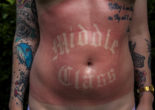Visual Vernacular: Artist Nazar Yahya
From Nazar Yahya’s “Rose Water: A Homage To Cy Twombly” Series (detail)
Nazar Yahya is an artist of great humility and patience whose hues and pieces illuminate the most delicate yet powerful parts of his culture. Born in Baghdad in 1963, Nazar’s youth and teen years evolved in art as his surroundings underwent massive changes.
“I was born and raised in Baghdad, the capital of Iraq, a historical city of thousands of years that has witnessed great culture of art, music, science, food, etcetera, as well as invasion, wars, coups and destruction,” Yahya says. “I was raised by well-educated and caring parents. My father was a journalist as well as accomplished photographer. However, the biggest influence on my artistic mind was my mother. Despite being a housewife, her work at home including cooking, sewing, and any other chores was done with precision and elegance. That’s where I learned the importance of details and perfection.”
At age of 18, he was an illustrator for a well-read and famous children’s magazine in Baghdad. This post had a major impact in shaping his mind, passion and interest in pursuing a fine art career, which lead him to enroll in fine art program in painting at the prestigious Academy of Fine Arts, Baghdad. As he worked with metal to make etchings and earth tones to paint along with draw, he further reflected on the cultural and political power in both the Middle East and then subsequently in the United States. In 2025, he moved to Houston with his family and he had another culture to examine and absorb, to ponder and compare.
From Nazar Yahya’s “Reconquista” Series
As he says in his artist statement: “They know about oil here, too. They know about the oil over there, too. Nowadays I do installations on inkjet on cotton paper. I have met heirs to the throne, and kept going back to that boy king who inherited his forefathers’ dominion only to see it vanish into thin Andalusian air. I realize now that not only this is what awaits Arab kings and princes, but that is also what awaits the future presidents of this great land. My art, and my writing tell the story of power gained and lost in disparate lands separated by oceans [of] time.”
His artwork has been exhibited extensively in the Middle East including in Beirut, Bahrain, Amman, Dubai, and Qatar. Other exhibitions include those in London, Norway, Bangladesh, and the United States. Yahya’s approach to his shows include thoughtful research manifested into visual velocity on a particular subject matter. Markers in each exhibition, including historical themes and childhood memories, continue to live and grow into the following exhibitions. He has taken poignant parts of his life and surroundings and turned them into a visual that evoke beauty and sorrow, happiness and pain.
“For my thinking, art is a research project,” says Yahya. “It is a methodology of linking the beauty of the subject mater with the evolution of concepts and thoughts. My artwork is normally influenced by historical, religious, and political events in the Arab and Islamic world. When I paint, I try to link historical events with current and future trends.”
In his series Rose Water: A Homage To Cy Twombly, Yahya used certain elements such as capturing the spirit of roses and rose water, evoking the experience of perfume to your senses with the abundance of purity are layered by color and texture on images from the artist. The Twombly-esque use of color and hand appear in reverence and revelation, as each image breathes a visual meditation of emotion. “It is important for me to have the viewer enjoy the beauty of the subject mater as well understand the methodology behind my thought and vision in completing the project,” he says.
From Nazar Yahya’s “Rose Water: A Homage To Cy Twombly” Series
His last exhibition, Love Dijla, Yahya drew out an imaginary world from which silky grids along photographs that grew temporal eras that joined and dissipated within the same frame. The Tigris River being the main subject evolves into various forms from the artists encounter with the water and what it hides in its rush downstream. “I was born near this river and watch the eternity of its rapidly flowing water, carrying boats, wandering between Karkh and Rasafa every day in the placid, peaceful life of the people of Bagdad,” reads Yahya’s statement about the exhibition. “This transports me from what I know of it now; it is a river that conceals anonymous massacred victims, feeding the fish in its waters. A nightmare resonates within the river, which turned into ink and blood at the time of the Mongols, it is now turning into blood and radiant toxic substances. The clash of this age of occupation can be heard against the voice of Jawahiri when he addressed the Tigris as an expatriate: From a far distance, I salute your foot; salute me.”
The history of thousands of years of civilization, science, literature, music, culture, as well as wars, invasions and destruction and the notion of illustrating these elements is all present in his artwork. What is presented to us viewers in nothing short of masterful movement of materials, poignant portraits of humanity and nature, and a beautifully haunting commentary on a veiled yet vibrant world we usually only see through misconstrued media. When one speaks to Nazar, you can understand through is delivery of eloquent and meaningful words why his art shows forth such placid magnitude and rich history. We look forward to seeing his future project of which he is in the process of researching: a concept of linking Leonardo da Vinci’s thoughts to his current life at the age of 52.
-
anaventura















